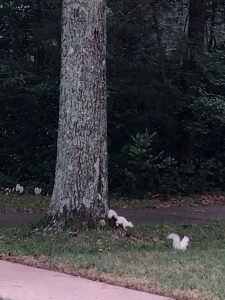
The first time I saw a white squirrel, I thought I had imagined it. Once I realized what I was seeing, it felt like it might bring good luck—similar to finding a four-leaf clover or seeing a shooting star. While it is a special and rare natural phenomenon, white squirrels are not completely unheard of in nature. One’s first impulse is to presume the squirrel is albino, unable to produce melanin and with reddish pink eyes. This does happen, but more often than not, what you are likely seeing is just a genetic variant of the common Eastern gray squirrel (Sciurus carolinensis). These are much more common than an albino. In fact, there are at least two “regular” white squirrels I see right now in my Pensacola neighborhood, scampering through the trees with gray squirrels. They have white fur, dark eyes, and are basically outliers in the genetic pool just like my own red-headed kids.

Most gray squirrels already have white fur on their bellies, a common type of countershading in the animal kingdom. Having a light-colored underside helps camouflage animals from predators that might be looking up from below, as the white blends into the bright sky. However, unless scampering in the sugar white sands of our beaches, being completely white seems counterproductive to hiding from predators like hawks and eagles, which have incredible vision. There must be some adaptive value, as we see white squirrels living in the same trees for years. A few studies have actually suggested that birds of prey do not register white squirrels as the type of prey they normally eat, so the coloration may actually protect them. In addition, a white squirrel crossing the road would be more easily avoided by cars than a gray cousin against the similarly colored pavement.
If you see a white squirrel in your neighborhood, you can report it online here as part of an ongoing population study managed out of North Carolina. You can also celebrate with them at the annual White Squirrel Festival! If you’ve seen a white squirrel in your neighborhood, let us know!
 2
2
